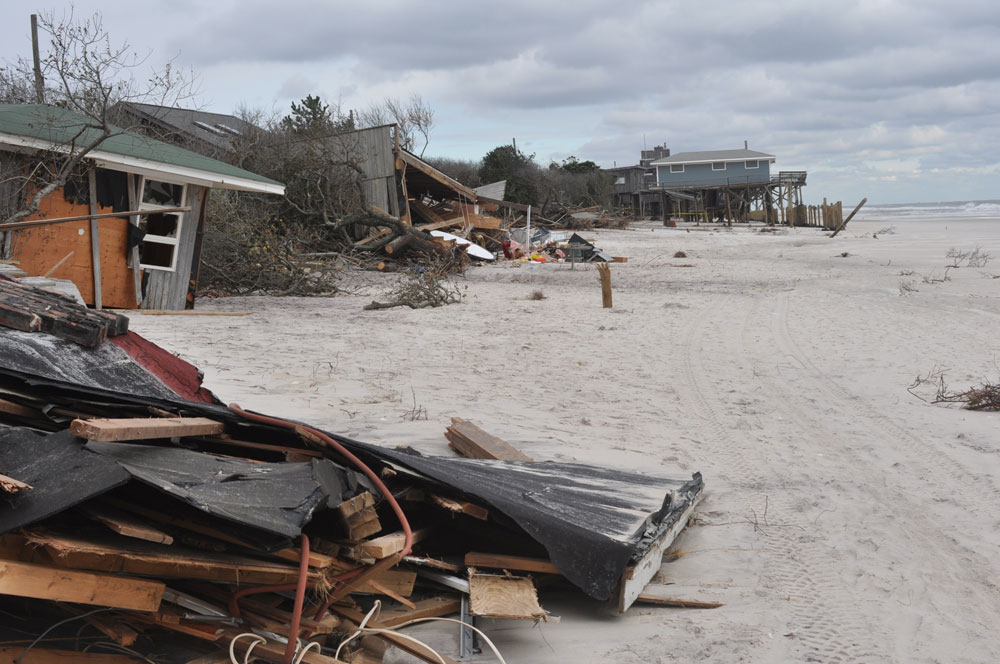Podcast: Play in new window | Download
Subscribe: RSS

Superstorm Sandy not only did this to Fire Island, NY, but made it easier to do again. (Photo: Cheryl Hapke, USGS)
A week after announcing her retirement, the director of the US Geological Service told a Washington DC conference that Superstorm Sandy fulfilled her worst climate-change nightmare: it blew out the natural defenses against storms along hundreds of miles of the Northeast coastline, leaving them vulnerable to any garden-variety nor’easter that comes along
The USGS is one of the agencies of the US government that tells us the truth, starting with its insistence at the time that the Dust Bowl of the 1930s was a man made disaster, a fact that is not widely enough understood to this day. But it is funded by Congress, and while it has not knuckled under to the knuckle draggers (by, for example, refusing to research global warming issues because many Congress Persons don’t believe in science), neither has it been especially strident about the clear and present danger of climate change, rising sea levels, more frequent and more potent storms, etc.
But there is apparently something about resigning from your responsibilities for wheedling money out of idiots that sets the tongue free. Marcia McNutt, speaking January 15 at a conference of the National Council for Science and the Environment (“Disasters And Environment: Science, Preparedness, And Resilience”), did not pull her punches (as soon as she had explained that she was not speaking as an official of the government, but as someone who knew what the hell she was talking about, to paraphrase).
Superstorm Sandy, she said, did far more than kill more than 250 people and inflict more than $65 billion in property damages; the storm wiped out the natural defenses against storms — the dunes, barrier islands and wetlands — along most of the northeastern coast.
What that means, as McNutt explained it, is chilling: “For the next storm, not even a super storm, even a run-of-the-mill nor’easter, the amount of breaches and the amount of coastal flooding will be widespread.” The cities of the Northeast, she said, are now “sitting ducks” for any storm that comes along. It’s the equivalent of playing professional football without helmets.
McNutt told the British newspaper The Guardian (the only one I have seen cover this story so far):
“Before Sandy, someone asked me what my climate change nightmare was. Before Sandy, I said it was that with the extra energy in the atmosphere-ocean system it feeds super storms that intersect mega-cities left rendered defenceless by rising seas. That is where we now are.”
McNutt admitted that it would be possible to replace the dunes and other features that were wiped out with bulldozers, at a cost of untold billions of dollars. Otherwise, nature will replace them, over hundreds of years. Meanwhile, the hundreds of thousands of people who are right now desperately rebuilding their beachfront, ocean view and Jersey Shore homes and businesses (with government help) need to know that their rebuilt structures will be far more vulnerable to much lesser storms than before.
However, unless they read The Guardian or The Daily Impact, how they gonna know?
Perhaps the first most coastal property holders will know of the significance of the loss of natural storm defences is when re-insurance corporations (who thrive by being very well informed) tell the east coast insurance industry (for some of whom it may be a surprise) that coastal property storm cover is heading out of reach for those who can’t self-insure.
Quite what the bounds of govt insurance will be between flood, storm surge, and storm wind remains to be seen. But the difficulty in getting even one half of Sandy’s damages out of Congress bodes ill for the funding of escalated damages from normal storms. So I wonder how many banks are going to carry mortgages on uninsured properties and business assets? And is it legal for them to do so ?
Regards,
Lewis
It’s my understanding that the private insurance industry quit insuring risky waterfront structures years ago, hence the National Flood Insurance Program. It has been out of money since Katrina, so what we have now is socialized water-soluble development.